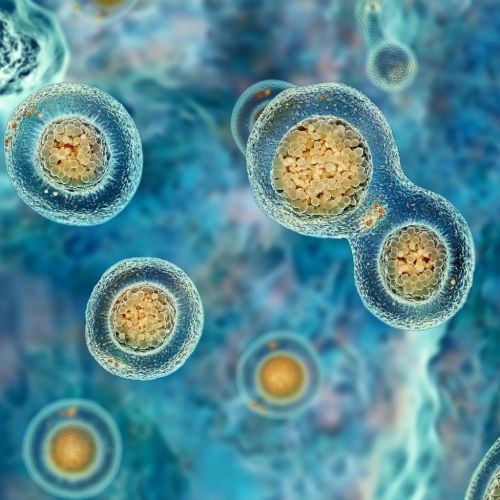Candidatus Endonucleobacter: Difference between revisions
No edit summary |
No edit summary |
||
| Line 42: | Line 42: | ||
* [[Metagenomics]] | * [[Metagenomics]] | ||
[[Image:Detail-98031.jpg|thumb|center|Microscopic image of marine bacteria within host cells.]] | [[Image:Detail-98031.jpg|thumb|center|Microscopic image of marine bacteria within host cells.|class=only_on_mobile]] | ||
[[Image:Detail-98032.jpg|thumb|center|Microscopic image of marine bacteria within host cells.|class=only_on_desktop]] | |||
== References == | == References == | ||
Latest revision as of 10:52, 20 September 2024
Introduction
Candidatus Endonucleobacter is a proposed genus of bacteria within the phylum Bacteroidetes. This genus is characterized by its unique intracellular lifestyle, predominantly found in marine environments. As a "Candidatus" taxon, it has not yet been cultured in a laboratory setting, and its classification is based primarily on molecular data, particularly 16S rRNA gene sequences.
Taxonomy and Classification
The classification of Candidatus Endonucleobacter is based on phylogenetic analyses of 16S rRNA gene sequences. It falls within the family Flavobacteriaceae, which is known for its diverse range of species that inhabit various environments, including marine, freshwater, and soil ecosystems.
Phylogenetic Placement
Phylogenetic studies have placed Candidatus Endonucleobacter within the Bacteroidetes phylum, closely related to other genera within the Flavobacteriaceae family. The genus is distinguished by its unique genetic markers and its intracellular lifestyle, which sets it apart from other members of the family.
Morphology and Physiology
Candidatus Endonucleobacter exhibits a rod-shaped morphology typical of many Bacteroidetes. However, detailed morphological characteristics are challenging to describe due to the lack of cultured isolates. The bacteria are known to reside within the cells of marine organisms, suggesting a symbiotic or parasitic relationship.
Intracellular Lifestyle
One of the defining features of Candidatus Endonucleobacter is its intracellular lifestyle. This genus has been identified within the cells of various marine organisms, including sponges and other invertebrates. The intracellular nature of these bacteria suggests a complex interaction with their hosts, potentially involving nutrient exchange or other symbiotic benefits.
Genomic Insights
The genomic information available for Candidatus Endonucleobacter is derived from metagenomic studies and single-cell sequencing. These techniques have provided insights into the genetic makeup of the genus, revealing genes associated with intracellular survival and host interaction.
Metabolic Pathways
Genomic analyses have identified several metabolic pathways that are likely crucial for the intracellular lifestyle of Candidatus Endonucleobacter. These include pathways for nutrient acquisition, stress response, and interaction with host cellular machinery. The presence of genes involved in the degradation of complex organic compounds suggests that these bacteria may play a role in the recycling of organic matter within their host organisms.
Ecological Role
Candidatus Endonucleobacter is primarily found in marine environments, where it inhabits the cells of various invertebrates. Its ecological role is not fully understood, but it is believed to contribute to the health and functioning of its host organisms.
Symbiotic Relationships
The intracellular lifestyle of Candidatus Endonucleobacter indicates a symbiotic relationship with its marine hosts. This relationship may involve the exchange of nutrients or other benefits that enhance the survival and fitness of both the bacteria and their hosts. Further research is needed to elucidate the specific nature of these interactions.
Research and Future Directions
The study of Candidatus Endonucleobacter is still in its early stages, and much remains to be discovered about this intriguing genus. Future research efforts will likely focus on isolating and culturing these bacteria, as well as exploring their interactions with host organisms in greater detail.
Cultivation Challenges
One of the primary challenges in studying Candidatus Endonucleobacter is the difficulty in cultivating these bacteria in a laboratory setting. Their intracellular lifestyle complicates traditional culturing methods, necessitating the development of novel techniques to grow and study these organisms in vitro.
Potential Applications
Understanding the biology and ecology of Candidatus Endonucleobacter could have several potential applications. For example, insights into their symbiotic relationships with marine organisms could inform the development of new biotechnological tools or strategies for marine conservation.
See Also


